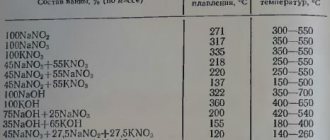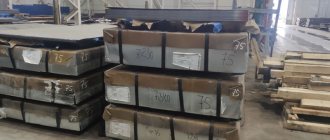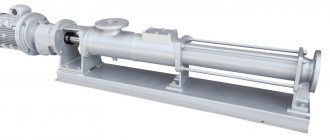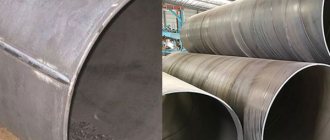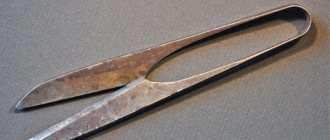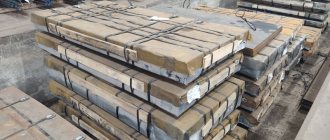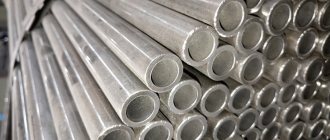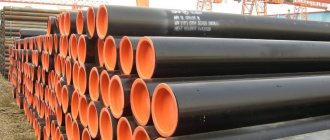“The cave tempts the knees”
Facts suggest that a thousand years ago in Rus' there were specialized workshops for the production of weapons from welding damask steel. The weapons made from damask steel were of very high quality and had a fine artistic finish. In Rus', from time immemorial, the epic epic glorified kharaluzhnye (colorful) swords and armor. Until the middle of the 15th century, damask steel was called kharaluzhnaya. Ancient Russian blacksmiths back in the 5th-8th centuries, as Russian archaeologists have established, knew how to skillfully make iron knives with steel blades, and already in the 9th-10th centuries they achieved a high level of technology for producing welding damask steel. The Russian traveler Afanasy Nikitin, who visited Persia, India and other countries of the East in 1466-1472, in his book “Walking across Three Seas” calls military armor and edged weapons made from eastern steel damask steel.
Princely warrior. The end of the 9th century - the first half of the 10th century. Damask steel sword, ax and defensive weapons of the northwestern type. Quiver, bow and belt - southeastern steppe type
The sword is the main weapon of the Russian warrior, a symbol of princely power and the military emblem of ancient Rus'. The warriors of the Kyiv prince Igor swore by the sword when concluding an agreement with the Greeks in 944. In the first half of the 9th century, the Baghdad philosopher Al-Kindi, in his treatise “On the various types of swords and the iron of good blades and on the localities after which they are called,” pointed out that Frankish and Slimane swords are “the best blades and are forged from steel, delivered from Ceylon and countries lying on the other side of the Ocus (Amu Darya).” Al-Kindi's contemporary, the Arab scholar IbnRust, called the people who owned the Slimane swords the Rus. The outstanding scientist of Khorezm Al-Biruni confirms: “The Rus made their swords from shaburkan (hard steel), and the fullers in the middle of them from narmokhan (soft steel) in order to give them strength upon impact and prevent their fragility.” In addition, the scientist reports that in Rus', weaving from long wires made from different types of iron, hard and soft, was used to make fullers.
In Rus', real, cast damask steel was also known. But could sabers made from real damask steel be made in Russia? There is no doubt that Russian blacksmiths knew how to forge a damask saber from wutz, but it was hardly possible to obtain damask steel until the end of the 18th century. The fact is that damask steel is primarily cast steel, and from Al-Biruni’s reports and studies of archaeological sites it follows that until the 18th century, both in Europe and in Russia, cast steel was not known and could not be made.
Old Russian sword made of damask steel
Old Russian swords stored in museums, and about eight dozen of them have been found, have a blade design similar to that described by AlBiruni. The base of the blade was made of iron or welded from three strips of steel and iron, and when it was welded only from steel, a low-carbon metal was used. In those days, patterned welding was also quite widely used, in which the base of the blade was made of a middle iron strip and two outer steel strips, specially welded. These strips consisted of several rods (layers) with different carbon contents, twisted and forged many times into a strip. Steel strips were welded into the end of the pre-welded and prepared block of the base of the blade - future blades. After welding, the blade was forged so that the steel strips came out of the blade. Having forged a blade of a given size, the handle handle was pulled out, after which the valleys (slots) were planed, and then the blade was polished and etched. Like the ancient Roman welding damask steel, Russian blades had a herringbone pattern.
Russian swords with “rare” patterns were in great demand in the markets of Byzantium, Central Asia and European countries. The Arab writer Ibn-Khordadbek wrote in the middle of the 9th century: “As for the Russian merchants - they are a tribe of Slavs - they export otter furs, fox furs and swords from the further ends of Slavonia to the Rumean (Black) Sea.” And in the correspondence between Ivan II and the Crimean Khan Mengli-Girey, in which the latter asks the Russian Tsar to send him armor, it is said: “This year the horses trampled the Orda Tatars, they wasted the small armor. I ask you, my brother, for some small armor.”
Monument to Afanasy Nikitin in Tver, Russian traveler, writer, Tver merchant (circa 1433-1472 (1475?))
Russian weapons were famous not only for the quality of steel, but also for its heat treatment. Thus, hardened steel in Rus' was called “triple ocel” (“resistant steel”). Damask steel and “whole” welded axes were found in burial mounds dating back to the 11th century. Until the 19th century, people in Russia knew how to make welding damask steel. In 1618, master gunsmith Nil Prosvit made a saber for Tsar Mikhail Fedorovich. The stripe of this saber is damask steel with slits (fulls), decorated with a notch with an inscription about the time of manufacture. There is information that, in addition to Nil Prosvit, blades from welding damask steel were made by Moscow craftsmen Bogdan Ignatiev, Dmitry Konovalov and others. In the 18th and 19th centuries, they knew how to make edged weapons from welding damask steel in Tula, where welding damask steel was called “red iron,” which was obtained by welding iron and steel strips in a wide variety of combinations. Tula gunsmiths used “red iron” to make barrels for shotguns and other firearms.
Types of annealing
To obtain an equilibrium structure, several heat treatment options are applied to steels. But in any case, there are three stages of the procedure:
- Heat.
- Excerpt.
- Cooling.
The holding parameters at each stage are selected according to the steel grade. In this case, it is possible to reduce internal stresses and increase plasticity to balance the structure.
The main difference between the different types is the temperature used. However, the method and speed of cooling also matters - sometimes it is performed extremely slowly, leaving the metal in the furnace, and sometimes the process takes place in the open air.
Iron Stream
At the beginning of the 18th century, Russian metallurgy began to develop rapidly. To implement his grandiose plans to expand the Russian state, Tsar Peter I needed a large number of high-quality weapons, and for their production they needed, first of all, iron and cast iron. Relying on domestic and foreign experience, Peter I organized iron ore mining and factory construction, unprecedented for that time. From 1700 to 1800, 123 ironworks were built in the Urals alone. By the end of the king’s life there were 233 of them, and by the end of the 18th century there were already 3,100 of them, not counting the mining factories. Pig iron production in Russia during this time increased from 150 thousand poods in 1700 to 9.91 million poods in 1800.
Abu-r-Raykhan Muhammad ibn Ahmad al-Biruni - Central Asian scientist-encyclopedist (4.09. 973 - 9.12.1048)
The victory of Russian metallurgy over Swedish was no less significant than the victory of the Russian army over the Swedes in 1721. For example, in 1716, the first batch of Russian iron in the amount of 2,200 pounds was exported to England, and in 1732, the export of iron already exceeded 200 thousand pounds. In 1722, a decree of Peter I was issued, which, in fact, gave the first technical conditions for the quality of iron:
“His Imperial Majesty ordered to send from the Berg College to all iron factories where iron is made, so that from now on the iron will be tested in this way, and released to the indicated places, and sold with the following marks.
First test: dig round pillars six inches thick in diameter into the ground so far that it is motionless, and hollow out holes in them the size of the strips, and push iron into that hole, and circle around that pillar three times, then back away from it. remove the post, and if it does not break, and there is no breaking mark, then stamp No. 1 on it in addition to the factory mark.
The second test: taking the iron strips, hit the anvil three times, then turn the other end back and hit them three times with all your might, and whichever one will withstand, and there will be no sign of a break, then each one, in addition to the factory mark, is branded with No. 2.
On the latter, which does not withstand those tests, put in addition to the factory stamps No. 3. And without stamps, strip iron should not be sold at all.”
Patterns of welding damask steel, enlarged 2-4 times
Each type of steel was rated according to its “own” number of “bends”: spring steel with six “bends”, coin steel with eight, tool and Damascus steel with twelve.
The leadership style of Peter I was also characterized by the strictest control over the implementation of his decrees. Thus, by decree dated January 11, 1723, he ordered: “The gun office from St. Petersburg should move to Tula and monitor the serviceability of the guns day and night. Let the clerks and clerks watch how Alderman places the brands. If you have doubts, check it yourself by inspection and shooting. And shoot two guns every month until they deteriorate. If a hitch occurs in the army, especially during a battle, due to the oversight of the clerks and clerks, the senior clerk will be given a job as a clerk, and the clerk will be deprived of his Sunday glass for a year.”
In the 18th century, Russia became the largest exporter of iron to Western Europe. In 1788 alone, 38.4 thousand tons of iron were exported from Russia to England and 5.8 thousand tons to other countries.
Zlatoust cavalry saber
In 1751, on November 20, the Tula industrialists Mosolovs entered into a contract with the Orenburg chancellery for the construction of an ironworks. In 1754, in the Kosotursky tract, on the Ai River, half a mile from the mouth of the Tesma River, the Zlatoust Plant was founded - one of the largest metallurgical plants in the Southern Urals. Having reached its design capacity, already in 1773 the plant was producing up to 140 thousand pounds of cast iron, 90 thousand pounds of iron and 1.885 thousand pounds of copper.
Over the course of 75 years, from 1701 to 1776, a whole complex of metallurgical plants was erected in the Urals: Nevyansky (1701), Kamensky (1701), Nizhne-Tagilsky (1725), Kononikolsky (1750), Preobrazhensky ( 1758), Verkhne-Avzyanopetrovsky (1755), Nizhne-Avzyanopetrovsky (1756), Katav-Ivanovsky (1757), Beloretsky (1761), Zlatoustovsky (1773), Miasssky (1776) . By the beginning of the 19th century, the Urals emerged as a grandiose industrial region on a global scale.
A copy of the saber of Tsar Mikhail Fedorovich, made by master gunsmith Ilya Prosvit.
Use of high-quality steel in products
It's not just weapons that need durable materials. Structural materials with special properties are used in a wide variety of industries.
Forged products work in cars, railways, agricultural machinery, and spaceships. Only very simplified technology is used. Forging is used to achieve fine grain in the structure of the metal. Possible cavities that are present in the castings are eliminated.
An example of a modern blade with a pronounced pattern:
There are pros and cons for Damascus steel.
Positive characteristics
- High strength of the product, withstands loads applied in different directions (compressive, tensile, bending and other types of loads).
- Wear resistance of the cutting edge, holds its edge for a long time.
- It has an unusual appearance, it is impossible to repeat the design on a similar object, it makes it recognizable.
- High cost of implementation.
A special type of Damascus steel made from wire rope:
The listed advantages often attract craftsmen to engage in production using the technology of repeated forging of workpieces. For each new batch of goods, its own forging methods and sequence can be used.
Flaws
The main disadvantage is the high labor costs for producing the product. It is necessary to resort to repeated heating of the workpiece.
High carbon steel is susceptible to corrosion. To the question: “Does it rust?” We can answer unequivocally that without proper care, rust quickly destroys the product.
Damascus steel fin, modern product:
A matter of national importance
In 1828, the government set the task: “At the Zlatoust arms factory, introduce the manufacture of sabers of equal quality to those made in Asia.” Soon the tsar was informed that “the best craftsman in Tiflis, Karamon Eliazaroshvili,” had pledged to reveal the “hereditary secret” he had received from his father Geurg (George) and “teach people to make weapons using this secret.” As a test, he made sabers and daggers from “real” (i.e. cast) and “in the manner of damask steel” (i.e. welding damask steel). At the same time, the master used both “Indian iron” and “Turkish steel”. “Turkish cast iron powder” is a traditional raw material that his ancestors dealt with in Erzurum. Thus, in 1833, the craftsmen of the Zlatoust state-owned factories were able to make weapons from welding damask steel, using iron and steel from domestic factories. “It is impossible not to recognize in Eliazaroshvili’s welding blades,” contemporaries responded, “a high dignity for sabers, which is proven by the very test often used on them, namely cutting off the head of a bull with one blow.” Eliazaroshvili himself received a thousand chervonets as a gift and was awarded a gold medal.
The Zlatoust plant was a metallurgical enterprise with a full cycle. The plant smelted cast iron from which hammers, anvils, wheels, cannonballs, bombs, weights, pots, pans and other household utensils were cast. In total, he produced 11 types of iron and steel.
Zlatoust dragoon officer's saber, model 1881
In 1812, a special white weapons factory was founded at the Zlatoust plant, which in 1816 sent the first batch of edged weapons along the Ai River. Soon Zlatoust became widely known for making mainly sabers of the “Damascus” type (welding damask steel). Ironically, these sabers were for some reason known as “Turkish”. In addition to sabers, the plant's weapons factory produced checkers, broadswords, sapper and high-quality hunting knives, which were famous far beyond the borders of Russia. However, tool steel was inferior in quality to English steel: cast steel was not yet produced at the plant.
Full and partial annealing
Thanks to proper heat treatment, after eliminating structural heterogeneity, it is easier to subject metals to cutting and other procedures. The classic types of steel annealing include complete and incomplete.
The first involves heating the metal 30-50 degrees above the critical point at the initial stage. When the structure turns into austenite, slow cooling in the furnace begins. Typically, this requires a dwell time of about one-quarter of the time required for heating.
The rate of slow cooling during complete annealing of steel depends on the grade:
- carbon ones require about 100-150 degrees per hour;
- alloyed - 30-50 degrees per hour.
The temperature drops to 400-600 degrees. As a result, ferrite and pearlite are formed. During annealing, cooling is performed not only in the furnace, but also in air if normalization is desired.
This method guarantees complete recrystallization. In coarse-grained steels the structure becomes fine-grained. The stress is removed from the metal, it is more viscous and soft. This method also helps to eliminate defects that formed during previous processing. For example, it is resorted to after casting or deformation, welding or heat treatment, which led to unfavorable results.
During incomplete annealing of steels, the temperature is maintained without exceeding the upper critical point. However, it must be higher than the lower critical value. This is followed by slow cooling.
Incomplete annealing of steel is resorted to in order to facilitate their processing by cutting. Therefore, it is rarely applicable to soft alloys. In addition, this type will not help get rid of defects.
This type of annealing is most in demand when working with tool steels. Since they become more amenable to cutting, the costs of subsequent processing are reduced.
Classified production
The secret of producing cast steel in Russia in the first quarter of the 19th century was the property of individual masters, for example, such as S.I. Badaev, who worked at the Kama-Votkinsk plant. Plushar in the “Encyclopedic Lexicon” for 1835 noted that Badayev’s tool steel is better than the famous “Guntsman”, that is, English. The master designed a special furnace with two sections: cementation and crucible. The red strip iron was subjected to cementation and then melted in crucibles. Then, using a carburizer consisting of various types of coal mixed with white clay, chalk and mineral additives, secondary carburization of the resulting steel was carried out. The Nizhny Novgorod manufacturer Polyukhov also received cast cemented steel of high quality. Polyukhov’s steel, according to the conclusion of the mint, “turned out to be suitable for the purpose of the instrument and has a durable rash that is fine and even.”
Zlatoust dragoon saber, model 1881
The manager of the Veletminsky plant, Ponomarev, also received cast steel, and the crucible steel production process was also carried out at the Verkhne-Isetsky, Nevyansk, and Kasli plants. However, due to the imperfection of technology at that time, steel was often of low quality or very expensive in cost.
For centuries, metallurgists from all countries and peoples tried to smelt damask steel, but no one was given the ill-fated secret. Many will say about damask steel that its secret has long been lost and “this secret is great!” And they won’t be very wrong, although only a hundred years ago, in 1906 alone, and in the Belgian city of Liege alone, 850 tons (!) of patterned steel of several dozen grades were produced. However, it was intended only for the manufacture of hunting rifle barrels, and at the same time, patterned steel blades throughout Europe were literally forged individually and according to special orders.
Zlatoust dagger made of “Damascus steel”
In the 19th century, metallurgical scientists made many attempts to uncover the secret of cast damask steel; even the great English scientist Faraday unsuccessfully struggled to solve this problem. But the beautiful and extremely varied patterns on damask steel remained a mystery.
What to look for when choosing
To remain completely satisfied with the purchase of a damask steel knife, you need to pay attention to:
- A chaotic drawing on a dark background - lines and dots should be clear and large, but not symmetrical. Smooth and symmetrical lines are a characteristic of cheaper Damascus steel.
- The ringing of monolithic damask steel is clear and long. If the blade is not solid (layers, fluctuations of various types), the sound will be low and short.
- A responsible manufacturer always indicates the purpose of the blade - the dimensions and parameters must match. The hunting blade is longer, the fishing and tourist blade is shorter, with a folding design.
- The assembly must be of high quality without gaps, burrs, etc.
- Documentation - warranty card, certificate (confirmation that this knife is a non-bladed weapon).
- Case/case.
Sharpening features
Damask steel is extremely strong, so sharpening it at home is not easy. It's better to entrust it to a pro. Such blades are sharpened with diamond stones, or a hard stone can be used.
As for the sharpening angle, you should stick to 30-45 degrees, the thickness of the edge should not exceed 0.5-1 mm.
Sharpening a damask knife.
The difference between crucible damask steel and cast steel
Now damask steel is produced using several technologies - the materials are generally identical, but they also have a number of differences.
When producing a crucible alloy, iron ore, charcoal and a special flux are heated in special crucibles - smelting is performed in wood furnaces (compared to gas or electric furnaces, they do not provide such a high temperature). The technology is costly, but that's what makes blades for collectors.
Damask steel blade.
Products made from cast damask steel are simpler; they can be found at sales in Moscow. The raw material for steel is not iron ore, but special grades of low-carbon steel.
It is easy to distinguish such damask steel - the pattern on the steel is not so pronounced, but the properties of the knives are practically the same. Of course, the price of cast material is several times lower.
Composition of damask steel
15.01.2019
Since people learned how to process metal, it is simply impossible to imagine life without knives.
They cut meat, cut fruit, give them as souvenirs and use them as weapons.
There are quite ordinary examples of such products, with a wooden or plastic handle, and there are one-piece, unique specimens, among which knives made of damask steel with a hardness of 64 HRC stand out.
Such blades have a long and interesting history, as well as their secrets. How they appeared, why they are better than other knives, and how to choose them – the material collected in the article will tell you.
What is damask steel and its characteristics
To understand what damask steel is, it is necessary to consider the process of its production from all sides.
This alloy is a very complex substance with a specific chemical composition, obtained thanks to a unique metal processing technology.
Bulat steel first appeared in India approximately 2400-2500 years ago. The material is an alloy of iron and carbon.
the latter is about 2%, which allows the product to maintain the elasticity of steel with a hardness comparable to the characteristics of cast iron.
Historical reference
Swords and knives made of damask steel appear in fairy tales and real historical references in many countries. A damask knife was always more expensive than a regular one, since it gave a real advantage in battle.
A little about ancient damask steel
Damask steel is an excellent choice for knives. It is an alloy of iron and carbon without additional alloying additives. But the high carbon content (almost like cast iron) makes it possible, after heat treatment, to obtain a hardness of up to 64 HRC. Another nuance - after etching, a damask blade has a characteristic beautiful pattern. That is why ancient damask steel in India, which is the birthplace of this alloy, was called Indian patterned steel - in ancient times it cost a fortune. The masters kept the secret of damask steel within the caste, but after Timur came to Syria, the captured masters moved to Samarkand with their secrets. It was there that the ancient technologies for producing high-quality damask steel were completely lost.
Bulat steel P.P. Anosova
Many specialists tried to restore the technical process of steel production with similar characteristics. Pavel Petrovich Anosov finally succeeded. The mining chief of the Zlatoust factories was actively interested in what damask steel was and how it could be produced on its own. A targeted study of this issue yielded results in 1837.
Anosov damask steel.
Anosov developed several technologies, including melting scraps in clay pots in high-temperature furnaces.
Return of a Legend
The open secret of damask steel production was again lost at the beginning of the 20th century. The next round of interest in technology began already in the Soviet period. Zlatoust metallurgist Sergei Baranov was able to repeat Anosov’s feat. A series of test melts made it possible to achieve the desired result, which confirmed the corresponding conclusion of the Russian Academy of Sciences.
Step-by-step technology for making damask steel from bearings
Products from finished ingots or billets are produced in the following sequence.
The inner ring of the bearing is made of ShKh-15 alloy. It is sawed with a grinder cutting disc and sent to the forge for heating. The desired heating temperature is 900…950 ⁰С.
The workpiece is held on the anvil with blacksmith tongs. By beating off the bulges with a hammer, a strip is formed from the ring.
The grinder gives the desired shape.
The workpiece is held in place using a special mandrel. A constant angle allows you to create identical slopes on both sides.
The final shape of the product is obtained by turning.
GOI paste and an auxiliary velvet roller help polish the surface.
After polishing, a finished blade is obtained. All that remains is to make the handle, bolster and sheath. Then the product can be considered finished.
Bulat - steel for the blade of a durable knife
Damask steel (vuts, taban, khorasan, farand) was known several thousand years ago. This material is distinguished by a complex production process, in which it is necessary to strictly observe the chemical composition of the alloy and provide a unique processing technology. All this allows us to obtain a material with excellent performance characteristics, which have not lost their relevance today, despite the abundance of various alloys and the use of a wide range of alloying elements.
Damask steel.

